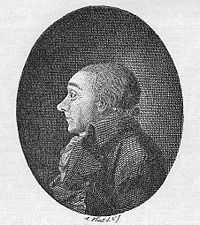Edvard Storm

Edvard Storm (21 August 1749 – 29 September 1794), was a poet from Vågå, Oppland, Norway. He was the son of Johan Storm, the priest in Vågå, and his second wife, Ingeborg Birgitta Røring. The first 7 years of his life were spent in the Vågå rectory, until he began school in 1756 in Christiania. In 1765 he took the entry examination for Copenhagen University, but waited until later to enter. For a period he was a teacher in Lesja, but he returned for the years 1766-1769 in his childhood home. His strong interest in nature and valley life were developed during these years.
In July 1769 Storm left home to begin serious study in Copenhagen; it is thought he pursued theology but he never took the official examination. It is possible that his interest in literature distracted him from his expected studies.
Despite being a Norwegian, he did not join the Norske Selskab, a literary club formed in 1772 for Norwegian students in Copenhagen which included authors, poets and philosophers. Storm was an admirer of the Danish poet Johannes Ewald though, and attached himself to Ewald's circle of friends who were members. But his upbringing in Norway had bound him firmly to the land. While in Denmark he wrote 9 songs in local dialect before the beginning of the 1770s. These songs were not only special as the first works he wrote, they were also among the seminal works of Norwegian literature in dialect, and are viewed as the best that Storm wrote.
Storm returned to his home district in about 1785. From this point forward his work with education was of considerable value. In 1786 a circle of the area's more important men created a folk school. Storm was a member of the group and came to play an important role in the administration of the school. Among the tasks to which the group dedicated its work was the important establishment of a middle school for children, and in this connection popular lectures were presented for older children and young people on topics from various scientific disciplines. Storm lectured four hours a week on lifemanship (Danish: Leveklogskab), geography, Danish linguistics and Greek and Norse mythologies. As the school itself got underway, Storm became quite busy. Not a day would pass that he didn't visit it, and he varied between himself teaching and supervising the teaching by others. Starting in 1790 his ties to the school got more formal as a head inspector of sorts. One month before his death he got appointed to be one of the directing managers of the Royal Danish Theatre.
His work included "Zinklars vise" ("The Ballad of Sinclair"), celebrating the defeat of a force of mercenary Scots under Captain George Sinclair's leadership by local forces led by a peasant girl Prillar-Guri. She lured the Scots into an ambush by playing of the traditional ram's horn. This battle is referred to as the Battle of Kringen.[1][2] The poem is characterized by the National Romanticism of the age, as was the bulk of his work.
Works
- Bræger, 1774.
- Adskilligt paa Vers, 1775.
- Infødsretten, 1778. Poem in 4 parts
- Fabler og Fortællinger i den Gellertske Smag, 1778.
- Samlede Digte, 1785.
References
|